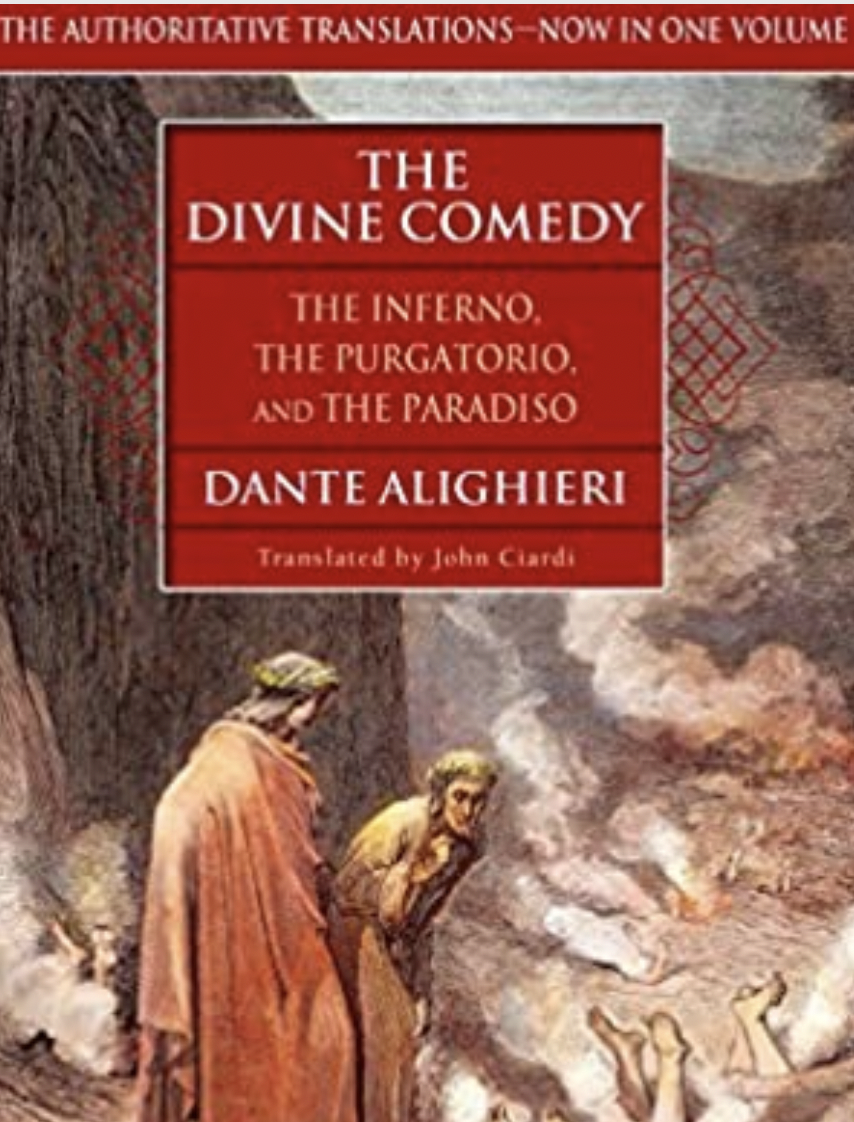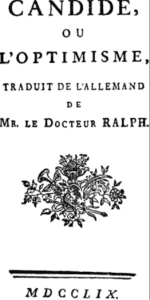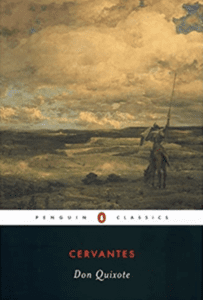Author: Dante Alighieri, an Italian poet, writer, and philosopher from Florence in the late 13th and early 14th centuries.
Dante lifted the Tuscan dialect, – the foundation of modern standard Italian, to the sublime heights of Virgil’s Latin or Homer’s Greek, with the glorious poetry of La Divina Commedia. In early Western literature, the reverse narrative of tragedy, – one with happy endings, was termed comedy. Written in the early fourteenth century when Dante was in exile from Florence for his political views, the poem was initially called ‘La Commedia di Dante Alighieri’. Boccaccio, the writer who illustrated and interpreted Commedia decades later, added the epithet ‘Divina’.
The poem is in three parts or canticas: Inferno, Purgatorio, and Paradiso, each divided into thirty-three cantos, with an initial canto as an introduction. An allegory representing the soul’s journey towards God, its structure is ruled by three and its multiples venerating the Holy Trinity, with ‘terza rima’ rhyme of three lines, – the second line of the first stanza rhyming with the first and third lines of the second stanza.
Dante, halfway through the Biblical lifespan at thirty-five, says in mid-life he lost the right way and found himself in a dark forest. A fictional first-person account beginning shortly before the dawn of Good Friday in the year 1300 and ending on the Thursday after Easter, Commedia reflects Dante’s political and moral views through the personages he meets. Dante is prevented from going towards the sun rising from behind the mountain by three beasts, – leopard, lion, and she-wolf representing sins of Incontinence, Violence, and Fraud. The ‘ombra’ or ‘shade’ or underworld spirit of Virgil guides him into Inferno or Hell, sent by Beatrice, the virtuous idol of Dante’s ‘courtly love’ who died young.
Funnel-shaped having nine concentric circles, with the inscription, “Abandon all hope, ye who enter here” on its gate, Hell has in the outermost vestibule souls who neither committed sins, nor cultivated virtues, neither praised God nor rebelled against Him. Boatman Charon hesitates to ferry living Dante across river Acheron to enter Hell’s first circle Limbo but is persuaded by Virgil.
Limbo, for virtuous pagans and heathens before Christ without salvation, contains shades of ancient luminaries like Homer, Socrates, Aristotle, Noah, Caesar, and Virgil himself. In the next eight circles, sinners are punished according to the principle of ‘contrapasso’ befitting the sins, – circles two to five for sins of Incontinence – Lust, Gluttony, Greed, and Wrath; circle six for Heresy; seven for sins of Violence – against neighbors, against self and against God; eight and nine for sins of Fraud, – eight for ten pits of Malebolge, and nine for Treachery.
The second circle for carnal sinners contains Dido, Cleopetra, Helen, Paris, Tristan, and adulteress Francesca da Rimini, killed by her husband having fallen for his brother, punished by incessant strong winds. The third circle for the gluttonous lying in a vile sludge of cold hail and rain is guarded by the three-headed dog Cerberus. The avaricious hoarders, spendthrifts, and misers, including popes and priests in the fourth circle guarded by Plutas, the Greek god of wealth, push heavy weights at each other. In the putrid river Styx of the fifth circle, the actively wrathful fight each other on the surface, while the passively wrathful or sullen sulk beneath the surface.
The travelers descend to Lower Hell surrounded by the Stygian marsh containing the City of Dis within its walls. In the sixth circle, the heretics, including Roman emperors, popes, and Greek philosopher Epicurus, are tortured in burning tombs. Evading the monster Minotaur, Dante enters the seventh circle. Murderers and plunderers are boiled in the burning blood-river Phlegethon in the outer ring, while Centaurs shoot at them. Suicides in the middle ring are gnawed at by harpies. In the inner ring, blasphemers, usurers, and sodomites, including Dante’s former mentor Brunetto Latini, wallow in burning sand and burning rain.
Virgil summons the monster Geryon to fly them over the cliff on its back to the eighth circle below the waterfall. The Malebolge of ten concentric ditches or ‘Bolgias’ contains panderers and seducers whipped by demons, flatterers drenched in excreta, simonists hung upside down with burning feet, soothsayers with heads twisted backward, ‘barrators’ or grafters immersed in boiling tar, hypocrites walking with lead garments, thieves bitten by reptiles, evil counselors including Ulysses engulfed in flames, discord inducers including Prophet Muhammad mutilated by demons, and falsifiers like alchemists, imposters, perjurers and counterfeiters ravaged by diseases.
Giants with feet on the banks of the frozen lake Cocytus of the ninth circle but torsos near the eighth are mistaken by Dante to be city towers. Virgil persuades a giant to lower them to the last circle on the palm of his hand. The four concentric rings of traitors in Cocytus consist of traitors against kin, country, guests, and benefactors respectively, with the first ring named after Cain and the last after Judas Iscariot. At the center, three-headed gigantic winged Lucifer is frozen waist-deep, chewing in his three mouths Cassius, Brutus, and Judas.
Dante and Virgil ascend from Hell and climb Mount Purgatory in the Southern Hemisphere with nine terraces, – two of Ante-purgatory for the Excommunicate and Late Repentant including kings; and the upper seven representing seven deadly sins, that of Perverted Love – Pride, Envy, and Wrath; Deficient Love – Sloth; Excessive Love – Covetousness, Gluttony, and Lust. Purgatorio emphasizes the motives behind the venial sins of the penitents, praising the associated virtues with prayer and beatitude, each depicting an event from the life of the Virgin Mary, – humility for the proud, generosity for the envious, gentleness for the wrathful, zeal for the slothful, piety for the covetous, temperance for the gluttonous, and chastity for the lustful.
Both Purgatorio and Paradiso draw more from Christian theology, while Inferno draws more from Classical sources. In both, descriptions of the sky and earth follow the geocentric cosmology model. The travelers meet Cato in Purgatory, embodying four Roman Catholic cardinal virtues of prudence, justice, fortitude, and temperance. Cato advises Virgil to wash the filth of Hell from Dante’s face and bind a reed signifying penitence around Dante’s waist. An angel inscribes seven ‘P’s on Dante’s forehead symbolizing seven ‘peccatum’ or sin, each erased as Dante crosses the corresponding terrace.
From the seventh terrace, Dante passes through a wall of flame and reaches the Earthly Paradise at the summit of the mountain. Dante witnesses a procession in this Garden of Eden with figures of allegorical significance including Beatrice, who now becomes Dante’s guide as Virgil returns to Limbo. Crossing the river Lethe which cleanses past sins, Dante joins Beatrice, who chastises Dante and makes him confess his sins, taking the purged Dante to Heaven.
Paradise or Heaven consists of nine celestial spheres in ascending order, – Moon for the Inconstant, deficient in the virtue of Fortitude; Mercury for the Ambitious, deficient in Justice; Venus for the Lovers, deficient in Temperance; Sun for the Wise, exemplifying Prudence; Mars for Faith Warriors, exemplifying Fortitude; Jupiter for Just Rulers, exemplifying Justice; Saturn for the Contemplatives, exemplifying Temperance; Fixed Stars for Faith, Hope, and Love, representing Church Triumphant; and Primum Mobile or First Moved for nine rings of Angels. The nine associated virtues are Cardinal virtues of Prudence, Justice, Temperance, and Fortitude; and Theological virtues of Faith, Hope, and Charity.
Dante meets blessed souls in Paradiso, which includes King Solomon, Constantine, and various saints such as St. Peter, who condemns Pope Boniface VIII whose wrath Dante incurred. In Primum Mobile, Beatrice narrates the story of creation, and Dante experiences God as a bright illumination surrounded by rings of angels. Beatrice ascends with Dante to Empyrean, the abode of God, where St. Bernard takes over as Dante’s guide.
The blessed, including Beatrice, dwell in God’s grace within an enormous rose. St. Bernard’s prayers to Virgin Mary for Dante culminated with Dante’s vision of the Triune God as three concentric circles of equal circumference. Dante experiences God, and Christ’s divinity and humanity, humbled by God’s love, which he has no words to express.




